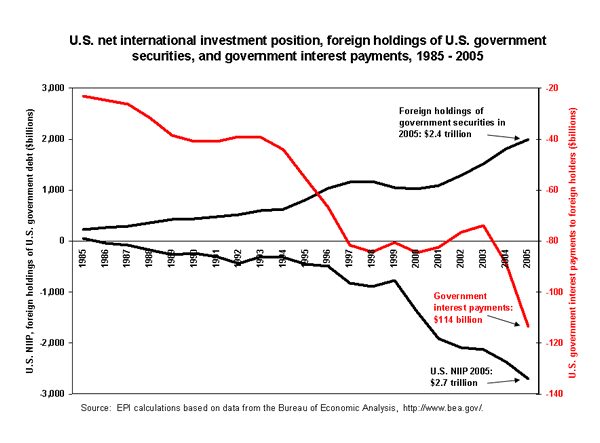June 30, 2006
Increases in foreign liabilities financed through sale of government securities
by Robert E. Scott
Mounting trade deficits have caused the United States to incur rapidly growing obligations to foreign investors. To finance the nation’s trade deficits, the United States must sell off more of its assets to foreign investors or reduce the stock of U.S. assets held overseas. According to the data in the latest report from the Bureau of Economic Analysis, the U.S. net international investment position (NIIP) deteriorated sharply from 1985 through 2005, as the asset sales necessary to finance trade deficits transformed the United States from the world’s strongest international asset position to the world’s largest liability position.
The United States’ NIIP amounted to a total debt of $2.7 trillion in 2005 (21.6% of U.S. gross domestic product), an increase of $333 billion over last year, as shown in the chart below. The largest share of this debt is in the form of foreigners holding U.S. government debt. Foreign holdings of U.S. government securities reached $2.4 trillion in 2005, an increase of $215 billion compared to last year. The purchases of U.S. government securities by foreign investors financed two-thirds of the increase in the net U.S. international liabilities during 2005.

The U.S. has to make increasing interest payments on this massive outstanding debt. Rising government payments to foreign holders of U.S. assets means that les money will be spent in the U.S. now and in the future. U.S. interest payments on that debt rose to $114 billion, which exceeds President Bush’s proposed budget for education, training, employment, and social services in 2007 of $86 billion (see EPI’s March 8, 2006 Economic Snapshot). Rising government payments to foreign holders of U.S. assets will reduce domestic incomes in the future. These debt payments also highlight the United States’ significant vulnerability to increases in interest rates. As interest rates in the United States go up, they could result in sharply higher payments to foreign holders of U.S. government debt and other securities in the future.
As a rule, a current account deficit (the broadest measure of the balance of trade in goods and services) must be financed through the sale of U.S. assets to foreign investors and lenders. However, the $333 billion increase in the net U.S. liability position in 2005 was considerably smaller than the current account deficit for the year ($-792 billion), largely because of a substantial increase in the value of foreign assets held by U.S. investors. The market value of foreign stocks held by domestic investors alone increased $384 billion in 2005, much more than the $69 billion increase in the value of foreign holdings of U.S. stocks.
Foreign central banks sharply increased their holdings of U.S. government securities in 2005, as they purchased dollar assets in order to artificially reduce the values of their currencies. China alone increased its holdings of foreign exchange reserves by at least $209 billion in 2005.1 As a result, the real value of the U.S. dollar gained 3.7% in 2005, despite growing trade deficits and the United States’ declining NIIP. The longer the dollar remains far too high, the greater the risk of a sudden break in the dollar, which would lead to financial disruption and a “hard landing” that would be disruptive to U.S. financial markets and interest-sensitive industries, at huge costs to the economy. The best way to avoid this threat is to bring about a gradual but substantial (on the order of 40%) reduction in the real, trade-weighted value of the dollar. Such a reduction would lower import growth, increase exports, and reduce the trade deficit. By intervening in U.S. currency markets to prevent dollar and trade adjustment, Asian governments are raising the risk of serious disruption to the economies of the United States and the rest of the world.
Note
1. Bank for International Settlements. 2006. BIS 76th Annual Report. Note, however, that the dollar share of foreign exchange reserve purchases dropped from 76% in 2004 to 53% in 2005, evidence of diversification away from dollars by central banks (BIS table V.1, p. 83). Note that disaggregated data on dollar holdings by country or region are not available in the BIS report. Some economists report that the BIS estimates understate China’s foreign exchange purchases in 2005 because it is purchasing large volumes of reserves through offshore, private institutions that it fails to disclose to other authorities.
To view archived editions of INTERNATIONAL PICTURE, click here.
